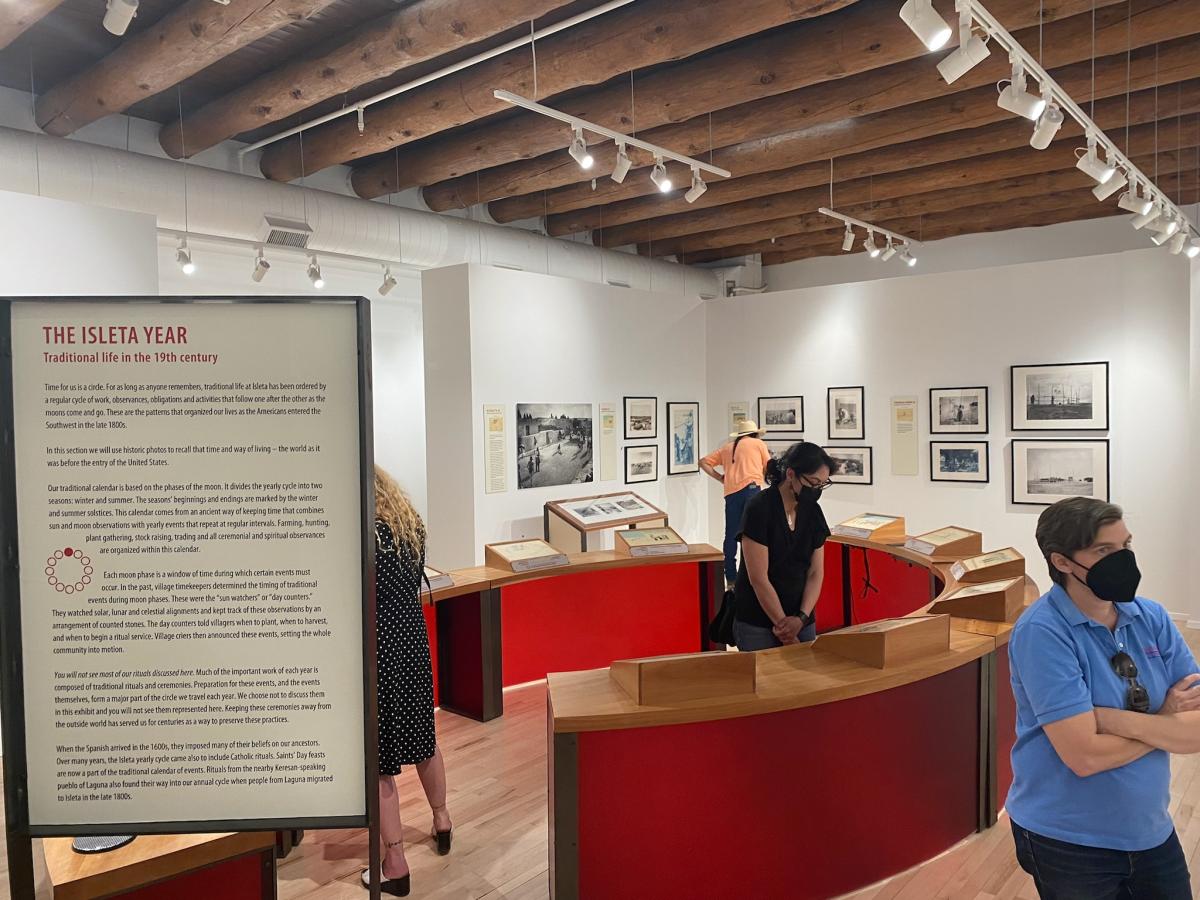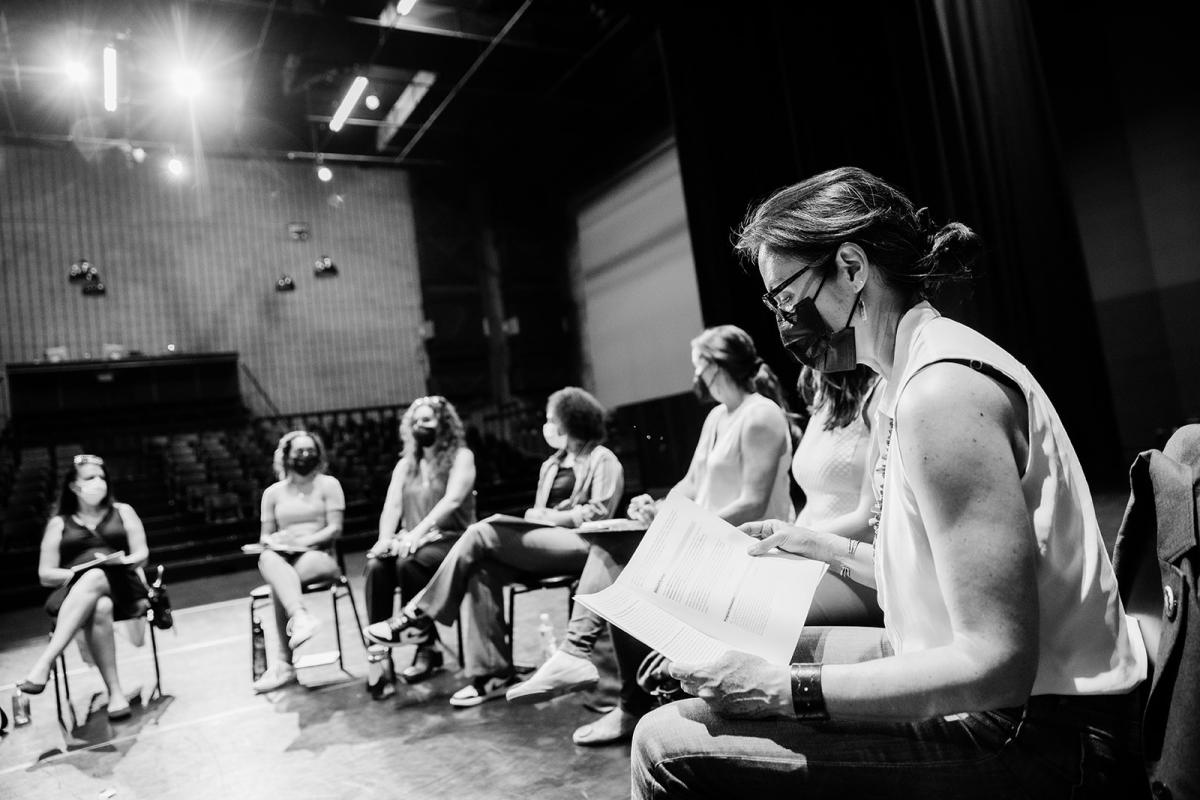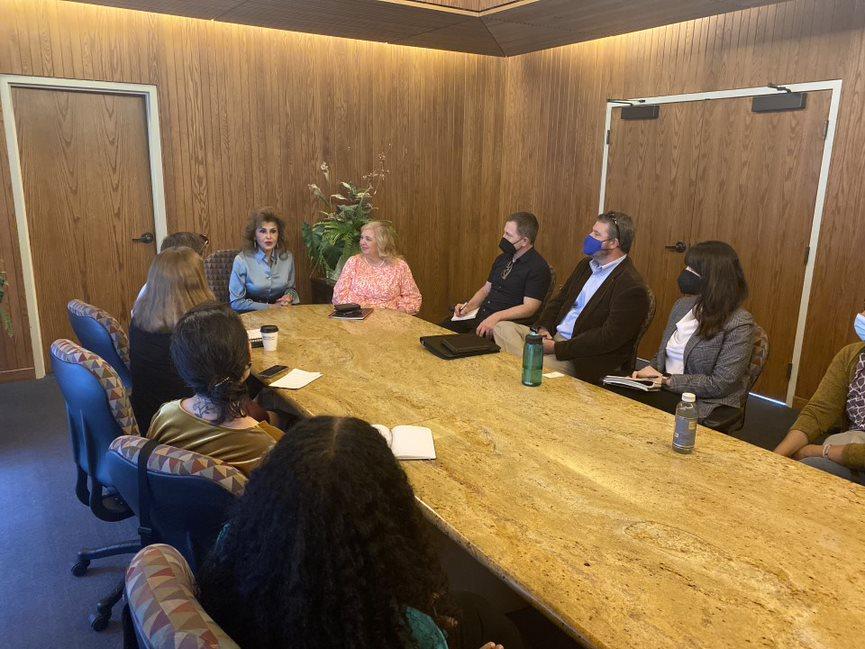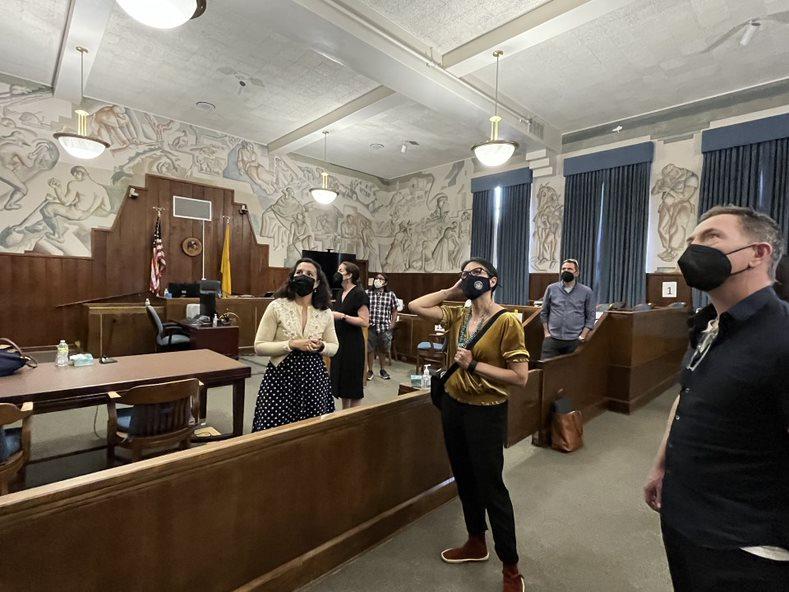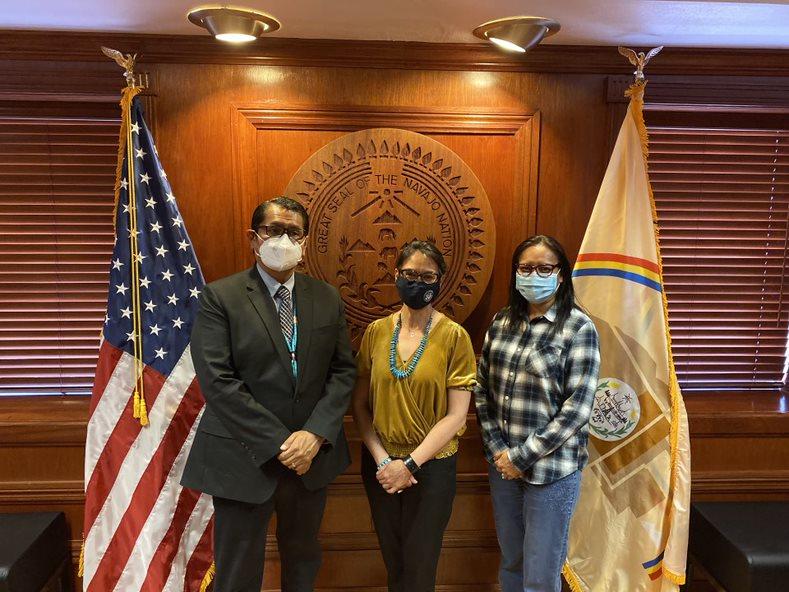Chair’s Travel: New Mexico & Arizona

Chair’s Travel: New Mexico & Arizona
Credit: Arielei Kinzer

Chair’s Travel: New Mexico & Arizona
Credit: Arielei Kinzer
On May 16, 2022, Shelly C. Lowe (Navajo) embarked on her first official trip as chair of the National Endowment for the Humanities (NEH), traveling throughout New Mexico and Arizona, with stops at NEH grantee and partner sites; the Navajo Nation capitol in Window Rock, Arizona; and the Healing Through Language conference. Throughout her travels, Chair Lowe experienced firsthand the impact of humanities support in the region and met with recipients of funding from both NEH and NEH’s state partner, the New Mexico Humanities Council.
Pueblo of Isleta | Isleta, New Mexico
Chair Lowe’s journey began in the Pueblo of Isleta, one of the larger of 19pueblos in New Mexico, located 15 miles south of Albuquerque in the Rio Grande Valley. Since 2001, NEH has supported the preservation and exhibition of Pueblo of Isleta history and culture, both in New Mexico and around the country. Chair Lowe met with Tribal Archivist Cassandra Smith at the Yonan An Cultural Center to learn more about NEH’s role in supporting the creation of a community-accessible digital photo archive. Opened in 2020, the Yonan An Cultural Center received funds through an NEH Sustaining the Humanities through the American Rescue Plan (SHARP) grant to retain and hire key staff, including its archivist and a Tiwa language scholar, to maintain and expand the Pueblo of Isleta archive.
While there, Chair Lowe also met with Pueblo of Isleta Governor Vernon Abeita, 1st Lieutenant Governor Virgil Lucero, and 2nd Lieutenant Governor Blane Sanchez and toured the exhibition “Time Exposures: Picturing a History of Isleta Pueblo in the 19th Century,” which was developed with support from three grants from NEH’s Division of Public Programs. The exhibition features archival photos, art, and testimony from the residents of the pueblo documenting both traditional life and rapid cultural change in Isleta during the nineteenth century. In the decade since its launch, the exhibition has traveled across the country before returning home to Pueblo of Isleta, with stops including the National Museum of the American Indian in New York, NY.
Healing Through Language Conference | Santa Fe, New Mexico
Though wildfires in the region prevented her from delivering remarks in person, Chair Lowe was able to participate virtually in the Healing Through Language conference hosted by the Multi-Indigenous Initiative Collaborative Action (MICA) Group, the Endangered Language Fund, and the Institute of the American Indian Arts on May 17, in Santa Fe. The workshop, funded by the National Science Foundation, brought a diverse array of experts together to assess the current state of linguistic preservation and revitalization in Indigenous communities and the impact this work has on the health and wellbeing of the communities involved.
Delivering the keynote address, Chair Lowe reflected on NEH’s work to document, preserve, and support the reinvigoration and teaching of endangered Indigenous languages. “Work being done by groups such as this is helping us hold on to the knowledge of our elders and makes it possible for children to hear and learn heritage languages at a young age,” said Chair Lowe.
Daryl Baldwin (Miami Tribe), a member of NEH’s advisory board, the National Council on the Humanities, attended the workshop and presented on the Myaamia Center at Miami University. The Center, a partnership between the university and the Miami Tribe of Oklahoma, works to revitalize the Miami language and foster community connection, research, and education. Chair Lowe noted in her remarks that Baldwin will play a key role in guiding NEH’s ongoing efforts to invest in effective language revitalization efforts.
Littleglobe & Keshet Dance and Center for the Arts | Santa Fe and Albuquerque, New Mexico
In Albuquerque, Chair Lowe and members of NEH staff were hosted by the New Mexico Humanities Council (NMHC), NEH’s state partner and one of 56 state and jurisdictional councils. Founded in 1972 and funded in part by NEH, NMHC supports public programs and special projects throughout the state, engaging New Mexicans with the humanities in their communities.
Chair Lowe was joined by a representative from the city of Santa Fe to meet with Littleglobe, a nonprofit recipient of NMHC funding that focuses on large-scale community engagement and local collaborative art and storytelling projects. In their meeting with Chair Lowe, the director and staff members of Littleglobe shared details of their story-based programming, including
Neighborhood Historians, a collaboration with Santa Fe Library that trained community members in multimedia storytelling and digital archiving to preserve the stories of Santa Fe residents.
At the Keshet Center for the Arts in Albuquerque, Chair Lowe met with the director and staff of the nonprofit to learn more about the M3 Program. “M3” stands for “Movement + Mentorship = Metamorphosis” and is a cornerstone of Keshet’s 25 years of arts and justice initiatives, developed to promote a community-based healing model within a reimagined justice system. A faculty of professional dancers and teaching artists work on-site with youth at New Mexico’s Youth Diagnostic and Development Center and the Camino Nuevo Youth Center, the state’s juvenile detention facility, creating a holistic environment to learn through movement.
National Hispanic Cultural Center & AfroMundo | Albuquerque, New Mexico
Chair Lowe also met with Dr. Margie Huerta, executive director, and Noël Merriam, artistic director, of the National Hispanic Cultural Center (NHCC) in Albuquerque. In October of 2021, NEH announced that nearly 300 institutions received NEH SHARP grants as part of the American Rescue Plan, including the NHCC. With this NEH support, the NHCC will begin work on a new project Voces de Latinidad, a digital storytelling archive of the Hispanic/Latinx identity and history both within the United States and in Albuquerque, specifically the Barelas neighborhood it calls home. Through community engagement, historians and scholars facilitate conversations with members of the Barelas community, preserving their family and collective histories on film, with a documentary to be released at the conclusion of the project. NHCC also received a recent NEH grant to digitize and make accessible its collections of Mexican American art and related materials, through a partnership with the University of Minnesota’s Rhizomes project.
Subsequently, Chair Lowe heard from Loida Maritza Pérez, Founder and Director of Albuquerque nonprofit AfroMundo which partnered with the NHCC for the 2022 Shared Roots: A Celebration of Afro-Latinx Culture festival, held April 16 – 23. Through the arts and humanities, AfroMundo amplifies the voices of the diaspora’s storytellers, historians, and culture-shapers, creating community and fostering dialogue through its annual festival and events. With support from the New Mexico Humanities Council, NHCC hosted film and documentary screenings, literary readings, and panels.
gallupARTS | Gallup, New Mexico
After her meetings in Albuquerque, Chair Lowe traveled west to Gallup, New Mexico, to meet with Rose Eason, executive director of gallupARTS, and board member Carol Sarath, along with Gallup and McKinley County artists. The recipient of the 2021 Governor’s Award for Excellence in the Arts, gallupARTS is a nonprofit arts council serving the Gallup community with a range of programs including galleries, art classes and youth education programs, workshops, grants, and special events.
With support from two Digital Projects for the Public Discovery grants from NEH’s Division of Public Programs, gallupARTS has launched the Gallup New Deal Art (GNDA) project, prototyping a new, interactive website showcasing and interpreting the city’s New Deal art collection. The GNDA project aims to preserve 150 historically significant artworks, housed in six locations, and make these widely accessible through a searchable, public database.
Navajo Nation Capitol | Window Rock, Arizona
Across the northwestern border of New Mexico is Window Rock, Arizona, the capital of the Navajo Nation. A Navajo citizen who grew up on the Navajo reservation in Ganado, Arizona, Chair Lowe was welcomed by Navajo Nation President Jonathan Nez and First Lady Phefelia Nez. In addition to discussing the humanities, Chair Lowe and President Nez spoke about the impact of the COVID-19 pandemic on the reservation community of more than 150,000 whom he represents, in an area that stretches 27,000 miles across Utah, Arizona, and New Mexico, and about public health measures that have helped reduce infection rates on the reservation. First Lady Nez spoke about important cultural institutions on the reservation and goals for supporting the Navajo people.
Ganado High School | Ganado, Arizona
Chair Lowe concluded her trip at her high school alma mater, Ganado High School, for an end-of-year address to students. The high school immerses students in the traditions and culture of the Navajo Nation and prepares students for success on their unique paths in life while affirming their Navajo identity.
In her remarks to the Ganado high school students on their final day of classes for the 2021 – 2022 school year, Chair Lowe discussed the role of the humanities in their education and lives outside the classroom. Later that week, Chair Lowe traveled to Boston, Massachusetts, to deliver the Lesley University commencement address, where she reflected on these ideas. “The humanities are part of everything we do. They are, quite literally, what make us human. The stories, teachings, and experiences—individual and collective—that inform how we live, how we interact with others and the natural world, and the decisions we make including why we make a certain decision over another,” said Chair Lowe. Watch the full address or download a PDF of the Chair’s remarks here.
